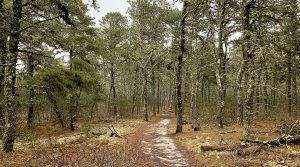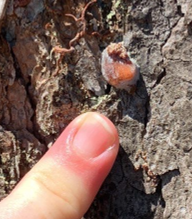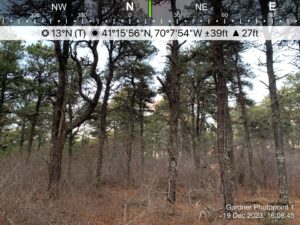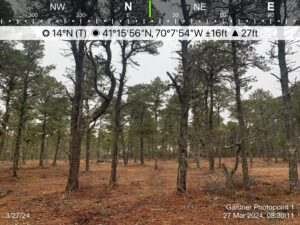Active Forest Management
In 2023/2024 the Land Bank performed the first active forest management project for SPB resilience on Nantucket at Gardner Farm at 151 Hummock Pond Road. This project was completed by Land Bank staff and was partially supported by a grant from MassWildlife.
In 2024/2025 the Land Bank will continue in house active forest management in the northern and western areas of Gardner Farm. This work will begin in November 2024 and continue through the winter season.
Winter 2025 the Land Bank will perform understory thinning at Hinsdale Forest. This property contained a thick scrub oak understory, which will be thinned to decrease the threats of wildfire and SPB. This will prepare the site for thinning of pitch pine in future years
Background
Scraggly pitch pine and scrub oak forests like those found at Gardner Farm are an iconic habitat of southeastern Massachusetts, the Cape, and the Islands. Despite their current ubiquity on the island, pitch pines were introduced to Nantucket in the 1800s to form a windbreak along Milestone Road. Pitch pine and scrub oak thrive on the low nutrient-sandy soils and harbor a plant and animal community that is adapted to withstand and flourish in the presence of frequent fire and other natural disturbance such as salt spray and drought. This habitat is often termed “pitch pine – scrub oak barrens”. European settlers used the term barrens because they could not cultivate their crops in these landscapes, but the areas are anything but bare. The unique barrens ecosystems support a diversity of rare plants, insects, and animals such as box turtles and bats. The Land Bank has big plans to actively manage these ecosystems to foster more resilient forests on island!

The pine barrens on Nantucket and regionwide have deteriorated due to minimal management and fire suppression since European settlers arrived. The habitats are now overmature; trees are densely packed and stressed for resources, and the understory diversity is decreased due to less sunlight reaching the ground through the crowded canopy and the deep layer of old needles and woody debris smothering new growth. The lack of host plants (i.e., plants that organisms live and subsist on) in the understory means there may be fewer moths and other insects available to support the federally endangered northern long-eared bat, which resides in these woods on Nantucket.
When under such stress, these characteristic ecosystems are not resilient in the face of multiple and increasing threats due to climate change. Our summers are becoming hotter, with droughts and stronger storms a more frequent occurrence. The stressed trees are vulnerable to forest disease. Wildfire and running crown fire, where fire jumps from tree to tree in the canopy, are a greater risk because the trees are close together and ladder fuels (i.e., small trees, brush, and dead branches/limbs) have accumulated.
Perhaps the most urgent threat facing our stressed pine stands is the range expansion of the southern pine beetle (SPB). This forest pest is native to the southeastern United States and has been moving north as winter temperatures have warmed over the recent decades. These beetles can disperse long distances in the air currents and prevailing winds. Once they infest a tree, they release pheromones which call in other beetles, quickly overwhelming the tree’s defenses. Trees attempt to “pitch out” the beetles by pushing them out with their sap or pitch. Stressed trees cannot mount an effective defense against the SPB and quickly succumb to the infestation within weeks. This summer, an outbreak of SPB was discovered by the Nantucket Conservation Foundation in their West Gate property and they acted quickly to halt the infestation by cutting trees showing signs of SPB. This forest pest has also caused several infestations this year on Martha’s Vineyard.

We now know that SPB is a threat that all pitch pine forest property owners will potentially have to grapple with in the near future. What can landowners and conservation groups do to prepare their forests to be resilient in the face of this threat and others, such as drought, disease, and wildfire? It turns out that the best recommendations from professional foresters, as well as state and federal agencies, center around managing the forests for “ecological integrity” and diminishing tree stress. Achieving more resilient pitch pine forests is the Land Bank’s management goal for these habitats. In the coming years, habitat management to reinforce the health of the overall forest habitat will include thinning overmature and overcrowded tree stands to maximize sunlight and airflow within the forest, promoting healthier trees and understories and more diversity in vascular plants, insects and the other animals that depend on these resources.

What can I do?
The Nantucket Southern Pine Beetle Working Group is encouraging the
public to report any trees showing symptoms of southern pine beetle infestation immediately to spb@nantucketconservation.org. Please include GPS coordinates,
specific directions, and a photo if possible.
Learn more:
- Sign up for public walks on Nov 8th & 10th
- Southern pine beetle info sheet
- The Future of our Forests – What a Southern Pine Beetle Outbreak Means for Nantucket
- Southern Pine Beetle Outbreak Detected on Nantucket Conservation Foundation Property
- Science Pub: Southern Pine Beetles and Massachusetts’ Forests
- MA DCR Forest Health Program Storyboard on southern pine beetle
- Yesterday’s Island – FIGHTING THE SPB



